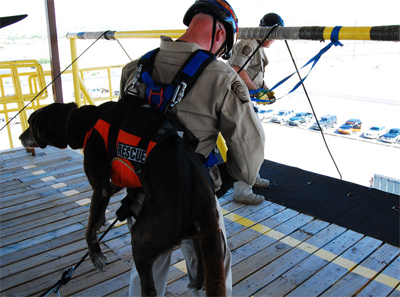
The border patrol's crack search and rescue unit is known as BORSTAR, which stands for Border Patrol Search, Trauma, and Rescue. The task of this agency is to respond to emergency search and rescue situations all over the country. The agents go above and beyond the call of duty to give assistance to those in need.
Chelsea is one of only 22 dogs in the border patrol's agency. At age 10, she is a seasoned veteran and often leads the way in the search. "Because our dogs are able to track so well, we've gotten over 366 lives saved," explains Supervisory Border Patrol Agent and Chelsea's handler Robert Noziska. "When a rescue is needed, many times the dogs must be helicoptered in to the remote area and must be able to rappel from the helicopter. A lot of times, the only way to get in is to rappel in. A helicopter can only get but so close with the dirt blowing up or the snow blowing up. If they can't land, you need to be able to rappel out of the helicopter with your team and the dog is part of our team."
Chelsea was the very first BORSTAR canine. She and Noziska inaugurated the search and rescue canine program in 2001. Ongoing training is a must. "You want to make sure that you train the dog to a high level so that the dog doesn't start panicking on the way down because that would be a little dangerous if the dog was fighting you while you need to control your descent," explains Noziska. The chocolate Lab wears a special harness that restricts her movement and allows her to ride on her owner's back. As a well-trained dog, she remains calm as they rappel 60 feet to the ground in 7 seconds.
The Lab and all of the BORSTAR dogs are excellent at what they do which is why they were selected. These dogs can mean the difference between life and death for hundreds of immigrants lost in the desert. "When you find someone, the reward is more than you can explain," says Noziska.